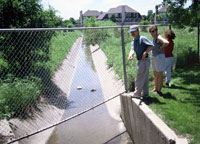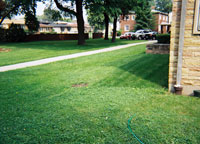Museum Exhibits - A River And Its City
A River and its City
“To many of those who may…visit Chicago, and still more, to those who come to make it their home, it may be not without interest to look back to its first beginnings; to contemplate the almost magical change which a few years have wrought; and from the past to augur the marvellous [sic] prosperity of the future.”
-Juliette Kinzie, 1856
Take a look out these windows at some of Chicago’s most famous buildings. These are the results of our early pioneers’ grand visions. If you look more closely, you might also see the results of Friends’ vision: growing and diversifying wildlife population, investment in public spaces, and people working together to care for and improve the river.
Explore the amazing changes taking place in our watershed.
The downtown river is full of life.
We’re not just talking about the wildlife on river tours or in pleasure boats or canoes! We’re talking about the beavers that are so abundant that trees at Wolf Point (near the Merchandise Mart) have protective fencing. American coots float beneath the Columbus Drive bridge. And peregrine falcons swoop overhead.
Peregrine Falcon
Courtesy of US Fish and Wildlife Digital Library Service
A vast variety of fish call the Main Stem their home, including pumpkinseed sunfish, emerald shiner, largemouth bass, smallmouth bass, and northern pike.
Smallmouth Bass
Courtesy of US Fish and Wildlife Digital Library Service
The river is for recreation and commerce.
Skilled crew teams, Olympic hopefuls, canoeists, and kayakers ply the river’s waters.
Chicago River Flatwater Classic at Grand Avenue, Chicago, Illinois
Courtesy of Friends of the Chicago River
Fishing is a popular sport, and the 2000 Bassmasters Classic was held in Chicago with contestants catching bass along the Main Stem.
2000 Bassmasters Classic, Main Stem, Chicago, Illinois
Courtesy of Friends of the Chicago River
Tour boats, pleasure craft, fishermen, and massive barges that carry sand, salt, and metal for recycling all share the river’s length.
Revealing a river once blocked from view takes work.
City of Northbrook
Once hidden and ignored, the Chicago River is now accessible to everyone. Native plants replaced invasive species along 1,390 feet of restored stream bank. The creation of ten pool and riffle complexes adds oxygen and provides habitat for fish and aquatic insects. And the city of Northbrook retrofitted an adjacent parking lot with new water quality filters to protect the river from polluted runoff.
West Fork, North Branch, Northbrook, Illinois
Courtesy of Friends of the Chicago River
Lake Katherine Nature Preserve
Located on the Cal Sag Channel in Palos Heights, this preserve was created on a spoil site in 1986. Today, Lake Katherine boasts 3.5 miles of trails, restored prairie and woodlands, planted gardens, and a nature center. Unusual migrant birds include large flocks of white pelicans.
Wildlife is abundant
About seventy species of fish live in the Chicago River, including yellow perch, bluegills, and catfish. Beaver, mink, mudpuppies, snapping turtles, dragonfly larvae, crayfish, and freshwater mussels do, too.
Yellow Perch
Courtesy of US Fish and Wildlife Digital Library Service
Birds in the watershed include the endangered black crowned night heron, bald eagles, kingfishers, sandhill cranes, bobolinks, owls, wild turkeys, and kestrels.
Black Crowned Night Heron
Courtesy of Friends of the Chicago River
Coyote, deer, fox, skunks, smooth green snakes, and bats roam the prairies and wooded areas. Salamanders, bullfrogs, box turtles, and water snakes hide in the wet areas near the river.
Coyote
Courtesy of Mike Greer
Industry is not the major cause of water pollution.
Though historically a major contributor to water pollution, industry has cleaned up its act. In a 2004 Illinois Environmental Protection Agency report on surface water quality, only three of the 176 watershed locations with known sources of impairment were industrial point sources.
What is the major cause of water pollution? Combined sewer overflows, stormwater runoff (everything draining from our streets, parking lots, and yards), and changes to a river’s natural flow and shape are all big contributors.
Runoff from a development in Northbrook, Illinois, damages forest preserves and pollutes the river.
Courtesy of Friends of the Chicago River
In other words, it is the combined impact of decisions made by everyday people that threaten the river’s health.
Unlike this example, if your downspout is disconnected, clean rainwater stays out of the sewer system.
Courtesy of Friends of the Chicago River
Chicagoland has more protected land than most metropolitan areas in the United States.
More than 100 years ago, visionaries like Jens Jensen and Dwight Perkins fought to protect natural areas here. In 1904, the Municipal Science Club pleaded that “the opportunity exists for preserving country naturally beautiful…all of these should be preserved for the benefit of the public…if ever lost, [they] cannot be restored for generations.”
Cook County residents took action by approving the creation of the Forest Preserve District of Cook County. Today, more than 70,000 acres are preserved in Lake and Cook counties. And the Chicago River watershed holds some of the nation’s best examples of rare oak savannas and tallgrass prairies.
Techny Basin, West Fork, Glenview, Illinois
Courtesy of Friends of the Chicago River
Mellody Farms, Middle Fork, North Branch, Lake Forest, Illinois
Courtesy of Friends of the Chicago River
You can be a part of improving the river and its watershed.
Some projects take time: replacing your pavement with permeable pavers or trading your grassy lawn for a native plant or rain garden. Both help the river by reducing runoff that can carry pollutants to the river.
Native plants are beneficial and beautiful.
Courtesy of Friends of the Chicago River
You can be involved by making simple choices: buy less hazardous cleaning products, limit your use of fertilizers and pesticides, and conserve water in your home.
It is important to stay informed and learn more about your impact on your watershed. And take the time to get to know your river.
Stormdrain Sticker, Deerfield, Illinois
Courtesy of Friends of the Chicago River


















